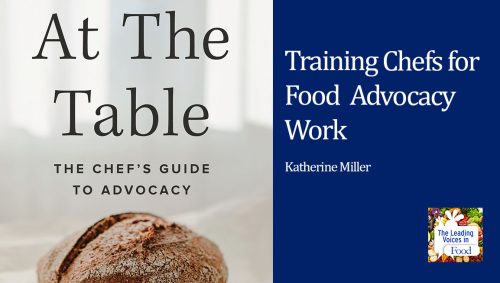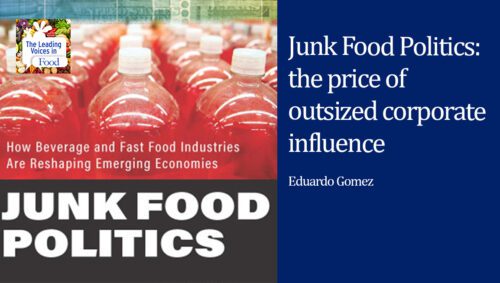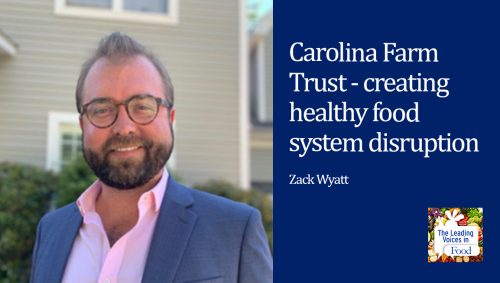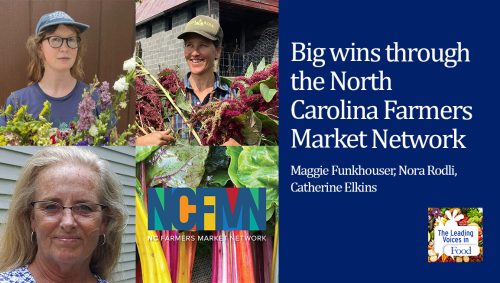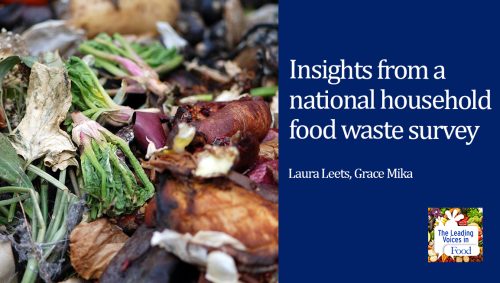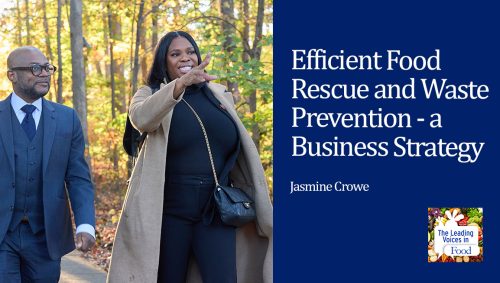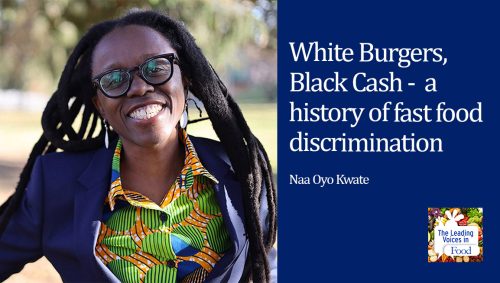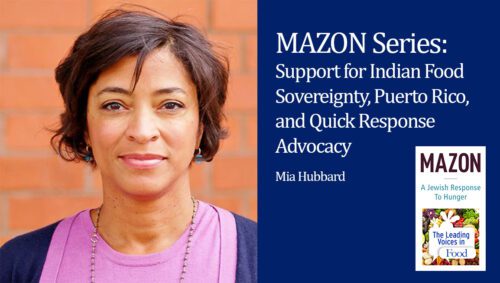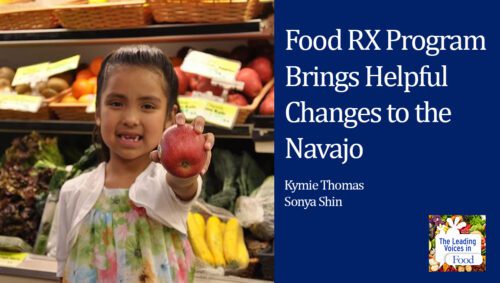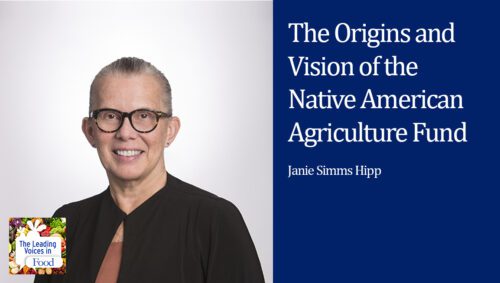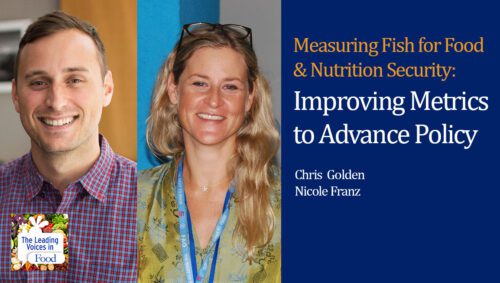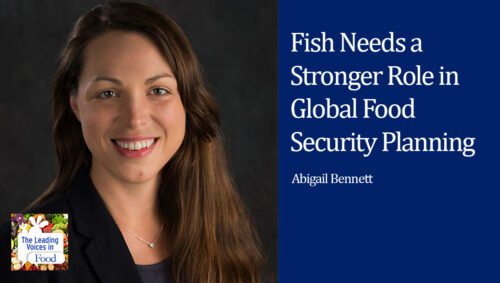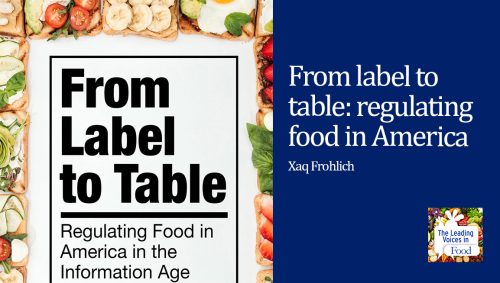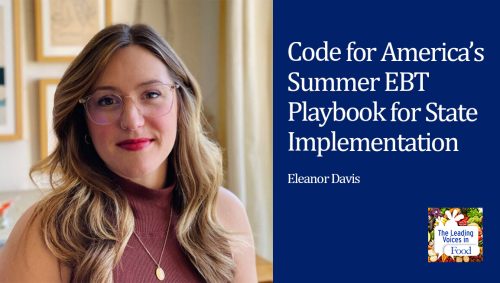The Leading Voices in Food
E102: Lyla June on Returning to Native American Agricultural Traditions
What if we cultivated our environment instead of intensive crop planting and animal farming, and in turn created an abundance of food to meet our needs? Is this what First Nations people did here in the Americas? This concept is the focus of doctoral research of today’s guest, Indigenous musician, scholar, and community organizer, Lyla June. June is an Indigenous woman of Dine (Navajo), Tsetsehestahese (Cheyenne) and European lineage. She’s pursuing a doctoral degree at the University of Alaska Fairbanks. And she’s fascinated by the intersection of Indigenous food systems and Indigenous land management.

Lyla June is an Indigenous musician, scholar and community organizer of Diné (Navajo), Tsétsêhéstâhese (Cheyenne) and European lineages. Her dynamic, multi-genre presentation style has engaged audiences across the globe towards personal, collective and ecological healing. She blends studies in Human Ecology at Stanford, graduate work in Indigenous Pedagogy, and the traditional worldview she grew up with to inform her music, perspectives and solutions. She is currently pursuing her doctoral degree, focusing on Indigenous food systems revitalization.
Interview Summary
So can you begin by explaining how you came to be passionate about food as an Indigenous woman? And tell us some about your doctoral work.
Sure, so as you may know, a lot of Native people are struggling with diabetes and other food-related illnesses and are having a hard time accessing foods. And a lot of us live in what they call food deserts. A lot of our food systems were destroyed in the process of the creation of America. Everything from decimating buffalo populations to burning down orchards and cornfields to ruining the salmon runs by putting dams in all the rivers; and destroying the beavers for the fur trade, which destroyed all the ponds which supported a lot of food systems. So our ways of life, as you can imagine, have been deeply altered, and that has its ramifications on our health.
I think you can’t help but be very attuned to food systems as an Indigenous person. I think what sparked my doctoral research is how tribes have, before Columbus and still do today these genius practices of taking care of the land that actually enhance the natural food-bearing capacity of the land. And what really sparked my interest in that was an elder who said to me, “Native people control enough land “to change the way the world thinks about food and water.” And that really inspired me because that made me feel like, you know, even though we’ve lost most of our land base, it doesn’t take a very large model to start a revolution in the way people think about things.
So I’ve been going around traveling as part of my doctoral research, recently reading a ton, but a lot of times just working face-to-face with Native people and seeing the ways in which they take care of the land. That’s really how I got into it. This belief that Native people could not only create thriving life for their own communities through the revitalization of our food systems—but that we could actually become leaders once again to help not just our communities, but to help the rest of the world. Although industrial agriculture seems like it’s working right now, it’s only a matter of time until it collapses. We are on the precipice of a very, I don’t think there’s any way to sugarcoat it, a very tragic famine. I think there’s a way around that with our current food system. And so I would like to work with a number, dozens and dozens and dozens and dozens of Indigenous peoples who are preparing for that, and ready to share our medicine and our knowledge with the world. If it’s okay, I’d like to share just a few vignettes of how Indigenous peoples are exemplifying this way of working with the Earth.
I’d very much like that. And what you’re saying sounds very concerning and very hopeful at the same time.
I feel that every day, a very strong mixture of urgency and hope all at once, and it’s exciting work. And I very much feel guided by the ancestors ’cause the things I’m learning and the things I’m coming across are just way too big for coincidence. But for example, there’s a group in British Columbia that I talk about very frequently called the Heiltsuk Nation. They live on a little island called Bella Bella, West Coast of Canada. And they actually have these hand-planted kelp forests that they plant along the shoreline of their islands. And at the right time of year, they go out and put this kelp, it’s very fast-growing kelp. And this increases the surface area upon which the herring fish, which is a little silver fish, can lay their eggs. And so they just litter the whole place with eggs, millions and millions and millions of eggs. And that provides the basis for the salmon, the killer whales, the sea lions. The humans, of course eat it. It’s a huge delicacy. You can sell it for tons of money, but they don’t sell it. They actually use it to feed their island ecosystem. So on up the food chain to the wolves, the eagles. And everyone in the system benefits from this anthropogenic base of calories. And I say anthropogenic, which means manmade.
There are ways to touch the Earth that are very kind and very helpful, not just in the feeding of humans, but of other lifeforms as well. Another example I like to give is the Shawnee ancestors of what we now call Kentucky. What we see is in the fossilized pollen if you take soil cores out of the ponds, you can see pollen that is as old as 10,000 years. And you can see what the forest has looked like over the past 10,000 years. And what we find is for a long time, it was just cedar and hemlock dominating the pollen profile. And then about 3,000 years ago, this is before Christ, we see the Shawnee ancestors move in and we see a huge influx of hickory nut, black walnut, chestnut, acorns, sumpweed, goosefoot. All these edible plant species come into the pollen profile. Which means that somebody, presumably the Shawnee, radically transformed the whole cedar and hemlock forest into a dense food forest. What we also see is the influx of fossilized charcoal, which indicates that they managed this food forest with low intensity, gentle, prescribed burns, where you burn the forest floor, which eliminates competing vegetation. It injects nutrient dense ash into the soil, phosphorus, nitrogen, potassium. It creates the charcoal which creates little apartment buildings for microbes in the soil. So you make a living soil. And this food forest with the charcoal persisted for 3,000 years, up until about 1830, we see the whole system collapse. All the pollen disappears, all the chestnut disappears. This is an example I like to give to show people how longstanding and how sophisticated Indigenous food systems are.
I have also been looking at the Tenochtitlan, which was the original city of Mexico City. They had these incredible waste sanitation systems where they say that human waste was so valuable on Lake Texcoco, way before Columbus was a twinkle in his daddy’s eye, that you could actually bring it to the market and trade it. You could trade your own waste for goods and services because they had this waste sanitation system that reinvested all of this so-called waste into their food systems, which were floating gardens they created out of reeds and very special soil systems. Gardens that floated all over Lake Texcoco. So if that’s not sophisticated, I don’t know what it is.
I’m really very impressed by those stories. And one of the things that you made me think of as you were describing the kelp forest in Canada, was that the food sounds like it’s part of the spiritual life of the individuals who were raising it, consuming it, protecting it, et cetera. Is that correct?
Oh, absolutely. In fact, there’s one elder I interviewed from the Amah Mutsun Nation who are the Indigenous peoples of what we now call Santa Cruz, California. And they did a similar forestry management strategy where they used prescribed burns. But he said that it was a ceremony. He said the smoke would go up into the oak trees because they’re oak people and those acorns form a very important caloric base for the pre-Columbian peoples of California. They were acorn people through and through. The smoke would go up through the trees and would smudge off the trees. It would bless the trees, he said. They had fire-resistant bark because they had co-evolved with human fire for so many millennia. And this smoke would kill all the weevils and bugs and pests. And so you had a really healthy acorn harvest in the fall. And so it was absolutely not just land management, but it was a prayer and a gift. Sort of like Vandana Shiva from India says. She says, “Nitrogen and potassium and phosphorus. “Those are elements in a periodic table “from a Eurocentric point of view.” She said, “But to us, these are sacred elements “that we give as an offering to the Earth. “We offer these nutrients to the soil “as a spiritual offering to Mother Earth.”
I’m struck as you’re discussing these conversations you’ve had with elders that they must be an invaluable source of information. And your discussions with them must be incredibly interesting, but they also must be very deeply moving, I assume.
Oh yes, absolutely, because we don’t have many of these elders left. And many of our elders don’t know this information because America very deliberately expunged this knowledge through the boarding school system. My grandparents, for example, full-blooded Navajo, full-blooded Dine, they don’t really know this type of knowledge. They were heavily Christianized as children in the boarding schools. They were heavily indoctrinated into this idea that white is right and brown is wrong. And the more like a white American you can be, then the more civilized you are, the more intelligent you are, the more holy and clean you are, which is absolutely what they taught Native children in the boarding schools. And it’s just ironic that our food systems were actually very, very intelligent, and very, very advanced.
The work that you’re doing including your doctoral work is an effort to protect this information, to preserve it, to communicate it, to amplify it. Are there a lot of other efforts around to do the same sort of thing?
Yes, I am one of many, many, many. It’s a beautiful thing that I don’t have to do this alone because Indigenous food systems as a movement is really burgeoning right now. For instance, you have a lot of eco-linguistic revitalization. The first Indigenous eco-village ever has sprung up in the South, the Muskogee Eco-Village. And they are a language immersion eco-village. So if you go there, everybody’s speaking Muskogee. And they understand that in order to revitalize their food ways, they must revitalize their language. And conversely, in order to revitalize their language, they must revitalize their food ways because their language talks about a certain world. And unless you recreate that world, there’s nothing to talk about. If that makes sense. There’s also a wonderful film that just came out called “Gather” and it’s available on, I think, iTunes and Amazon. And it’s all about the fight to revitalize Native food ways. It’s really well done, and has a lot of Indigenous speakers leading the charge. There’s the Indigenous Food Systems Network, indigenousfoodsystems.org that is really bringing together a number of players in this broad-based movement. There’s also this really interesting phenomenon popping up, the popularization of Indigenous culinary arts. For instance, you have The Sioux Chef, which I imagine many of you have heard of. He’s a Lakota chef, and Sioux is spelled S-I-O-U-X, which is one of the names for Lakota. So The Sioux Chef has written a book called, “The Sioux Chef’s Kitchen,” all about natural Indigenous-based dishes that you can make. There’s also Taste of Native Cuisine, Carlos Baca, based out of Southwest Colorado, who has his own farm. And he’s been foraging and creating these amazing culinary dishes, like top-notch, five-star, but he’s bringing all of that to the people. And he’s been bringing food boxes to people on the Navajo Reservation during the COVID crisis to give them real medicine, not just food, but also plant, different medicines to help. And then there’s Yazzie The Chef was a Dine, a Navajo chef who’s really been talking up our food ways. Rowan White, who’s based in Northern California, but she’s a Mohawk woman. She is leading the effort in seed rematriation, and she calls it rematriation instead of repatriation, kind of as a feminist take on all of that. But what she does is she gets all of these Indigenous seeds and she grows them, and replicates them, and proliferates them on her property. Everything from heirloom corn to heirloom amaranth to heirloom squashes and different Indigenous sage, tobacco. She builds up this seed bank, and then she gives it back to the Reservations. She gives all the seeds back to the people. So she’s doing incredibly important work to preserve the genetic integrity of our food systems by saving and proliferating the seeds.
Those are really interesting examples. And it’s inspiring to hear about all the activity in this area, and gives us some hope for the future that we can learn from the past. So let’s turn back to your doctoral work. Tell us a little bit more about what you’re doing in the context of your doctoral work.
I just finished my last course. So I’m now embarking on the dissertation writing and sort of taking the writing I’ve already done and synthesizing it and getting it ready. I won’t claim to have an answer of what my dissertation is exactly. I’m kind of right in the middle of the process. But what I’m thinking is really taking all of these different case studies, which include the Heiltsuk, the Shawnee, the Amah Mutsun, ancestors of Tenochtitlan, the Menominee Tribal Enterprises where they have this amazing Indigenous forestry program where they’ve managed a forest for a hundred years and logged to the forest for a hundred year, and yet it has increased its biomass. And I’m hoping to generate some theory out of that, to do grounded theory, you know, where you look at what you see. You find commonalities. You find common denominators among all of these food systems and you develop some characteristics of Indigenous food systems. You develop some basic foundational principles. So that’s my current strategy for now.
I just went to some land in Kentucky, and we’re thinking of actually recreating some of these food forests. And that’s my ultimate goal. Whether it’s a part of the dissertation or not, we’re absolutely going to be putting all this knowledge into practice, because as I said, control enough land to change the way people think about food and water. My task, I feel, is to create these models, and have them be living, breathing systems that people can come and visit, and see, and taste, and feel, and say, “Hey, another way of food is absolutely possible. “Let’s do it.” You know, one that is not monoculture. One that not just honors biodiversity, but cultivates biodiversity. One that recharges the soil instead of depleting it. One that really honors the ceremonial aspect of food. One that doesn’t call it food anymore because food is like a lifeless object, but honors the fact that it’s a living, breathing being that gave its life so that we can live. You know, that’s what food really is. One of the common denominators among all these food systems which I find incredibly fascinating is the construction of habitat. That is what a lot of our food systems seem to be about, where we actually construct an environment that is hospitable to certain species that we eat. And then those species come to us.
Lyla, let me ask you one final question. This has been a fascinating discussion by the way. So one argument that you hear in defense of industrial agriculture practices is that they can be done to scale. And so the traditional practices that you’re describing, people might support even in principle, but say you just can’t do enough of it to feed the world. What is your reaction to that idea?
It’s a little bit contradictory because the more you create monoculture industrial agriculture at scale. The more you deplete the soils. The more you compromise the genetic integrity of the plants and animals. Because if you have all monoculture then you have narrowed the genetic pool. And that all has a whole cascade of negative consequences. So you might say it’s scalable, right? But at what costs and for how long? That’s the real question.
People think that there weren’t that many Native Americans here in North America. Well, we densely populated the land, and we managed the land extensively with these food forests, My point is, if we have these food systems, right? These food forests, for example, they actually strengthen the ability of other food systems to exist. Diversity creates diversity. So they’re not just scalable, it’s actually required to scale up in order for there to be a complex, multi-bioregion ecosystem. You need to start building up these polyculture food systems. You need to start building up the biodiversity. So to answer your question, not only are Indigenous food systems scalable, but they’re the only thing that’s scalable. They’re the only thing that’s going to last.


